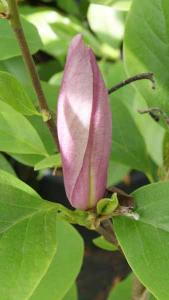Magnolia Sentinel
Flowering Magnolia with Long Lasting Blooms
1. Add items to basket
2. Go to the basket
3. Enter your postcode in Delivery Price Check
Magnolia Sentinel is a deciduous spring-blooming magnolia with long-lasting pale pink flowers. It’s an upright variety and a perfect specimen tree for borders or compact gardens.
Magnolia are ancient plants found in fossil records across the world, but now they are only native to South America and the Far East. They were named after French botanist Pierre Magnol in the early 1700s when they found their way to Europe with the plant hunters.
Magnolia Sentinel was bred to have a longer flowering season than other magnolias and for its upright columnar habit. Its goblet-shaped long-lasting blooms appear on bare branches in early spring. The buds are an attractive deep pink, before opening to pretty pale pink and there’s often a second flowering in summer. Attractive dark green glossy foliage emerges after the blooms and falls when the frosts arrive.
Magnolia Sentinel is an excellent choice if your outdoor space is compact and you need an upright shrub or tree with long-lasting spring flowers.
Height And Spread of Magnolia Sentinel
Magnolia Sentinel reaches a maximum height of 10 metres over 10 years.
How Hardy Is Magnolia Sentinel
This is a winter hardy magnolia that can withstand minus temperatures in well-drained soil, but it needs shelter from harsh, cold winds and shouldn’t be planted in a frost pocket.
How To Use Magnolia Sentinel
Because Magnolia Sentinel has a longer flowering period than many other varieties of magnolia it’s a top choice of specimen tree in a sheltered, sunny spot.
Magnolia suit both country cottage style gardens with their pretty flowers but also urban courtyards with their structural shapes and goblet style flowers.
Sentinel is perfect for woodland borders, sheltered front gardens, and Japanese style spaces.
How To Care For Magnolia Sentinel
Magnolia Sentinel prefers a sunny, sheltered spot that’s protected from harsh wind and lingering frost that damages the buds and prevents the anticipated flower show.
It does best in neutral to slightly acidic soil but will manage in alkaline conditions too. If your garden is very chalky, fill the planting hole with ericaceous compost and top it up with a yearly acidic mulch of pine or bracken-based compost.
Pruning isn’t needed because magnolia tends to grow in a naturally open goblet shape, but if necessary you can prune back any dead or crossed branches in midsummer after the flowering has finished. Remember to give new trees plenty of water until they are established. The biggest killer of new trees and shrubs is a lack of water.











